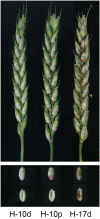Two transcription factors TaPpm1 and TaPpb1 co-regulate anthocyanin biosynthesis in purple pericarps of wheat
- PMID: 29562292
- PMCID: PMC5920291
- DOI: 10.1093/jxb/ery101
Two transcription factors TaPpm1 and TaPpb1 co-regulate anthocyanin biosynthesis in purple pericarps of wheat
Abstract
Purple pericarps of bread wheat (Triticum aestivum L.) are a useful source of dietary anthocyanins. Previous mapping results indicated that the purple pericarp trait is controlled by two complementary genes located on chromosomes 7D and 2A. However, the identity of the genes and the mechanisms by which they regulate the trait are unknown. In this study, two transcription factors were characterised as anthocyanin activators in purple pericarps: TaPpm1 (purple pericarp-MYB 1) and TaPpb1 (purple pericarp-bHLH 1). Three non-functional variants were detected in the coding sequence of TaPpm1 from non-purple seed lines, in which the function of TaPpm1 was destroyed either by insertion-induced frame shifts or truncated peptides. There were six 261-bp tandem repeats in the promoter region of TaPpb1 in the purple-grained varieties, while there was only one repeat unit present in the non-purple varieties. Furthermore, using yeast two-hybrid, dual luciferase, yeast one-hybrid, and transient assays, we were able to demonstrate that the interaction of TaPpm1 and TaPpb1 co-regulates the synthesis of anthocyanin. Overall, our results provide a better understanding of the molecular basis of anthocyanin synthesis in the wheat pericarp and indicate the existence of an integrated regulatory mechanism that controls production.
Figures







References
-
- Bagge M, Xia X, Lübberstedt T. 2007. Functional markers in wheat. Current Opinion in Plant Biology 10, 211–216. - PubMed
-
- Bartłomiej S, Justyna RK, Ewa N. 2012. Bioactive compounds in cereal grains – occurrence, structure, technological significance and nutritional benefits – a review. Food Science and Technology International 18, 559–568. - PubMed
-
- Baudry A, Caboche M, Lepiniec L. 2006. TT8 controls its own expression in a feedback regulation involving TTG1 and homologous MYB and bHLH factors, allowing a strong and cell-specific accumulation of flavonoids in Arabidopsis thaliana. The Plant Journal 46, 768–779. - PubMed
-
- Baudry A, Heim MA, Dubreucq B, Caboche M, Weisshaar B, Lepiniec L. 2004. TT2, TT8, and TTG1 synergistically specify the expression of BANYULS and proanthocyanidin biosynthesis in Arabidopsis thaliana. The Plant Journal 39, 366–380. - PubMed
Publication types
MeSH terms
Substances
LinkOut - more resources
Full Text Sources
Other Literature Sources

